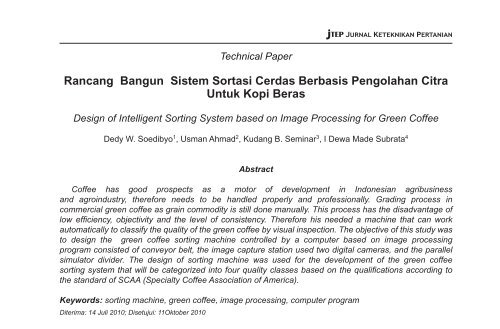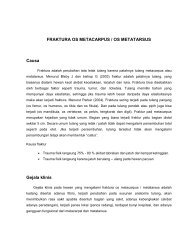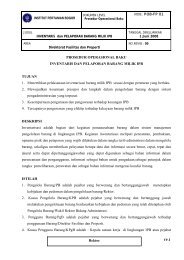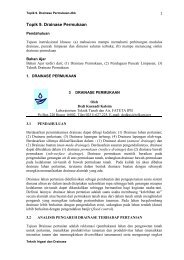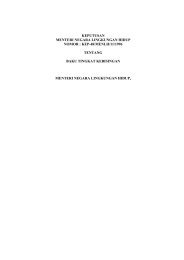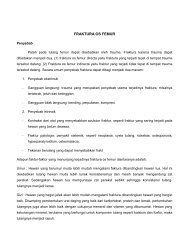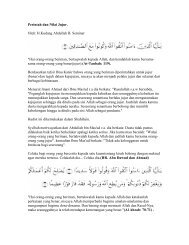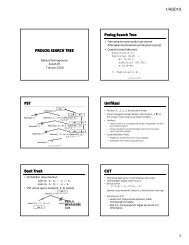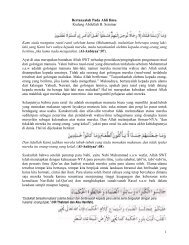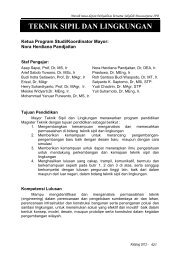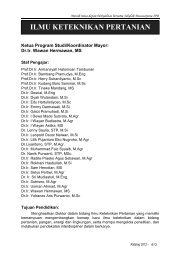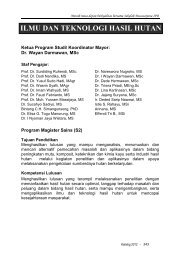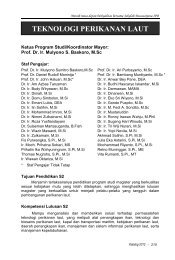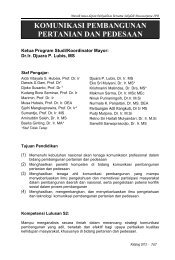Rancang Bangun Sistem Sortasi Cerdas Berbasis Pengolahan ... - IPB
Rancang Bangun Sistem Sortasi Cerdas Berbasis Pengolahan ... - IPB
Rancang Bangun Sistem Sortasi Cerdas Berbasis Pengolahan ... - IPB
You also want an ePaper? Increase the reach of your titles
YUMPU automatically turns print PDFs into web optimized ePapers that Google loves.
Technical Paper<br />
<strong>Rancang</strong> <strong>Bangun</strong> <strong>Sistem</strong> <strong>Sortasi</strong> <strong>Cerdas</strong> <strong>Berbasis</strong> <strong>Pengolahan</strong> Citra<br />
Untuk Kopi Beras<br />
Design of Intelligent Sorting System based on Image Processing for Green Coffee<br />
Dedy W. Soedibyo 1 , Usman Ahmad 2 , Kudang B. Seminar 3 , I Dewa Made Subrata 4<br />
Abstract<br />
Coffee has good prospects as a motor of development in Indonesian agribusiness<br />
and agroindustry, therefore needs to be handled properly and professionally. Grading process in<br />
commercial green coffee as grain commodity is still done manually. This process has the disadvantage of<br />
low efficiency, objectivity and the level of consistency. Therefore his needed a machine that can work<br />
automatically to classify the quality of the green coffee by visual inspection. The objective of this study was<br />
to design the green coffee sorting machine controlled by a computer based on image processing<br />
program consisted of conveyor belt, the image capture station used two digital cameras, and the parallel<br />
simulator divider. The design of sorting machine was used for the development of the green coffee<br />
sorting system that will be categorized into four quality classes based on the qualifications according to<br />
the standard of SCAA (Specialty Coffee Association of America).<br />
Keywords: sorting machine, green coffee, image processing, computer program<br />
Diterima: 14 Juli 2010; Disetujui: 11Oktober 2010
Technical Paper<br />
Kinerja Pengeringan Chip Ubi Kayu<br />
Performance of Cassava Chip Drying<br />
Sandi Asmara 1 dan Warji 2<br />
Abstract<br />
Lampung Province is the largest producer of cassava in Indonesia. Cassava has a weakness that is<br />
easily damaged and could not be stored longer. To overcome this, there is a need of an effective drying<br />
process so that cassava can be processed into other materials of lower power use as well as its economic<br />
value. A hybrid drying system is one solution to resolve the issue. The purpose of this research is to study<br />
the performance of drying cassava chips by using a hybrid type of dryer rack. The process of drying cassava<br />
chips made using a three-stage treatments with three replicates with the input load of 30 kg of cassava<br />
chips. The results showed that the pattern of decline in water levels in each treatment is uneven. The time<br />
needed to dry cassava chips to reach the water content of 10% - 12% in the drying of materials using<br />
sunlight for 18 hours, using electrical energy for 16 hours and use the energy of sunlight and electricity for<br />
12 hours. The higher temperatures produced the shorter the time required in the drying process. Electrical<br />
energy required for the drying process using electric energy was 91 440 kJ and drying using electrical<br />
energy and sunlight was 68600 kJ.<br />
Keywords: cassava chip, drying, dryer hybrid<br />
Diterima: 13 Maret 2010; Disetujui: 17 Setember 2010
Technical Paper<br />
Pengembangan Algoritma <strong>Pengolahan</strong> Citra untuk Menghindari<br />
Rintangan pada Traktor Tanpa Awak<br />
Development of Image Processing Algorithms for Obstacle Avoidance on Unmanned<br />
Tractor<br />
Usman Ahmad 1 , Desrial 2 , I Dewa Made Subrata 3 , Sjahrul Annas 4<br />
Abstract<br />
Unmanned tractors, even though it uses global positioning system (GPS) technology to identify the<br />
working path, still require an ability to recognize the environment in front of it in order to avoid obstacles that<br />
may exist. A device that can be used to recognize the environment in front of the tractor and avoid obstacles<br />
that may exist, is the camera. However, images captured by the camera need to be processed to detect<br />
possible obstacles at the front of the tractor. This study aimed to develop image processing algorithms to<br />
detect the possible presence of obstacles on the path to be traversed by an unmanned tractor, and directed<br />
the tractor to a safe path by giving the new coordinates when there are obstacles in front of it. Several<br />
image processing techniques such as edge detection, opening and closing, marking free area, and the<br />
determination of the coordinates were used for the purpose of directing the path in front of the tractor when<br />
there are obstacles that must be avoided.<br />
Keywords: image processing, obstacles, unmanned tractor, algorithms<br />
Diterima: 19 April 2010; Disetujui: 18 Oktober 2010
Technical Paper<br />
Pengembangan Program Komputer untuk Pemilihan Kincir Angin<br />
Pembangkit Tenaga Listrik di Pedesaan<br />
Development of the Computer Program for Selecting Windmills-Generated Electric<br />
Power in Rural Areas<br />
Rusnia Zaidun 1 dan Mad Yamin 2<br />
Abstract<br />
Rural areas which have not getting electricity networks provided by Perusahaan Listrik Negara or<br />
PLN can consider constructing windmills to generate electricity. In the construction of these windmills, a<br />
special attention should be paid to such factors as topography of the location and wind speed in the site<br />
of windmills so that a proper type of windmills that will be used in the area can be decided. Therefore,<br />
developing a computer program for selecting the type of windmills used is expected to serve as an input for<br />
the development of agricultural technologies that utilize renewable energy. Making the computer program<br />
consists of the following steps: making the initial view layout of the program, program scripts, animation, and<br />
program evaluation. Making a program design is started by determining the input and output components of<br />
the program so as to set the initial view of the program. Based on the formulas used for windmills generating<br />
electricity, a computer program to determine the type of windmills was developed by using Visual Basic 6.0.<br />
Meanwhile, Adobe Flash CS3 Professional software was used to construct animated windmills, which can<br />
also be run under Visual Basic 6.0 program.<br />
Keywords: windmill, energy, electricity, power<br />
Diterima: 14 Mei 2010; Disetujui: 6 September 2010
Technical Paper<br />
Rasio Input Energi dan Volume Reaktan pada Penerapan Ultrasonik<br />
untuk <strong>Pengolahan</strong> Biodiesel<br />
Ratio Input on Energy and Volume Reactants Application for Ultrasonic Processing<br />
Biodiesel<br />
Bambang Susilo 1 , La Chovia Hawa 2 dan Moch. Bagus Hermanto 2<br />
Abstract<br />
The application of ultrasonic on biodiesel processing can increase the reaction rate and improve the<br />
conversion of plant oils into biodiesel. Factors affecting the rate of reaction on the application of ultrasonic<br />
waves for biodiesel processing are temperature increasing, acoustic mixing, onset of cavitations and<br />
surface tension on the micro bubble, and the formation of hot spots in the form of instantaneous pressure<br />
and high temperature on the molecular scale. The vibrator dipped into the reactants transferred mechanical<br />
energy which was transformed into heat, cavitations and hot spots. This research was conducted to see<br />
the effect of the volume ratio of reactants and input energy on the rate of conversion of triglycerides into<br />
biodiesel. The results of this study demonstrated a significant effect of the energy input to the conversion of<br />
triglycerides into biodiesel. The greater specific input energy produced the higher conversion and the higher<br />
reaction rate. Input energy by using ultrasonic was significantly lower than the use of a mechanical stirrer.<br />
Keywords: ultrasonic, input energy, biodiesel, conversion rate<br />
Diterima: 14 Mei 2010; Disetujui: 28 September 2010
Technical Paper<br />
Analisis <strong>Sistem</strong> Proses Pindah Massa pada Ekstraksi Secara Mekanik<br />
Minyak Kedelai (Glycine Max Oil)<br />
System Analyze of Mass Transfer Process in Mechanical Extraction Soybean Oil<br />
(Glycine Max Oil)<br />
Bambang Dwi Argo 1<br />
Abstract<br />
Soybean, a vegetable protein-rich commodity needed to improve public nutrition, safe to consume, and<br />
the price affordable. The purpose of this research are to: 1. determine the effect of pressure and time of<br />
extraction the mass balance, yield and level of soybean oil extraction, 2. Gain mass transfer coefficient value<br />
in soybean oil extraction process, and 3. analyze the mechanism of mass changes during the extraction<br />
process soybean oil is mechanically using hydraulic pressing. Oil obtained results indicate an increase<br />
due to the influence of a given amount of pressure and length of time silenced. The greater the pressure<br />
exerted, the more oil produced this shows soybean oil can come out with a maximum at the greatest<br />
pressure of 200 kg/cm 2 . Mass transfer coefficient in soybean oil extraction process at a pressure of 100 kg/<br />
cm 2 5.57x10 -5 gcm 3 /cm seconds. In the pressure is 200 kg/cm 2 15.39 x 10 -5 g cm 3 /cm seconds.<br />
Keywords: mass transfer, mechanical extraction, soybean oil<br />
Diterima: 12 Maret 2010; Disetujui: 7 September 2010
Technical Paper<br />
Pengaruh Penyusutan Temu Putih (Curcuma zedoaria (Berg) Roscoe)<br />
Terhadap Karakteristik Pengeringan Lapisan Tipis<br />
The Effects of Shrinkage to Thin Layer Drying Characteristics of Temu Putih (Curcuma<br />
zedoaria (Berg) Roscoe)<br />
Inge Scorpi Tulliza 1 , Armansyah H.Tambunan 2 dan Usman Ahmad 3<br />
Abstract<br />
The objective of this study is to analyze the occurrence of shrinkage during thin layer drying of Temu<br />
Putih (Curcuma zedoaria (Berg) Roscoe) and its effects to the drying characteristics. The experiments were<br />
conducted using a laboratory scale dryer with data acquisition and equipped with machine vision system.<br />
The drying conditions was controlled at temperatures (T) of 50°C, 60°C, 70°C, relative humidity (RH) 20%,<br />
30%, 40%, 50% and air velocity 0.78 m/s – 1.95 m/s with a specific combinations. The results show that<br />
the temu putih’s slices were shrinking as the moisture content was decreasing with almost linier correlation.<br />
The drying data was used to determine the drying constants using three models, namely Henderson and<br />
Pabis, Lewis, and Page model. The effects of the shrinkage to the drying characteristics is discussed in<br />
term of the relation between surface area ratio (AR) to moisture ratio (MR).<br />
Keywords: Drying;Thin Layer drying; Shrinkage; Temu Putih<br />
Diterima: 24 Maret 2010; Disetujui: 13 September 2010
Technical Paper<br />
Aplikasi Jaringan Syaraf Tiruan (JST) Untuk Pendugaan Suhu Larutan<br />
Nutrisi yang Disirkulasikan dan Didinginkan Siang-Malam pada<br />
Tanaman Tomat Hidroponik<br />
Application of Artificial Neural Network (ANN) for Estimating Temperature of Circulated<br />
and Day-Night Cooled Nutrient Solution on Hydroponics System for Tomato<br />
Chusnul Arif 1 , Y. Aris Purwanto 2 , Herry Suhardiyanto 3 , Yudi Chadirin 4<br />
Abstract<br />
Cultivation of tomato plant under hydroponics system in the greenhouse is suitable way to improve<br />
fruit quality since it is easier to control environmental parameters. In this system, water and nutrition are<br />
two important things for plant to growth. In the tropical area such as Indonesia, air temperature is main<br />
constraint in the plant production system. Increasing air temperature inside the greenhouse has positive<br />
correlation to the raising temperature of nutrient solution which affected to the ability of the plant to absord<br />
the nutrition. The effective way to anticipate increasing of its temperature is by using the cooling system<br />
of nutrient solution before circulated to the plant. This paper presented the application of Articificial Neural<br />
Network (ANN) to estimate the temperature of nutrient solution which was cooled on day-night time and<br />
circulated to the plant. ANN models, called time delay neural network, consist of 3 layers with 4 input nodes<br />
and 1 output node. As input model were t (time), Tg(i) (air temperature inside the greenhouse on time i),<br />
Tt(i) (temperature of nutrient solution in the tank on time i), Tb(i-1) (temperature of nutrient solution in the<br />
plant plots on time i-1) and as output model was Tb(i) (temperature of nutrient solution in the plant plots<br />
on time i). The model was developed well with validation result better than heat transfer model previously<br />
indicated by coefficient determination (R2) of 0.9498.<br />
Keywords: cooling, nutrient solution, hydroponic, tomato, artificial neural network<br />
Diterima: 15 Juni 2010; Disetujui: 30 juli 2010
Technical Paper<br />
Analisis Dimensi Fraktal untuk Identifikasi Tanaman dengan<br />
Pendekatan Pemrosesan Citra Secara Paralel<br />
Fractal Dimension Analisys for Plants Identification with Paralel Image Processing<br />
Approach<br />
Mohamad Solahudin 1 dan Kudang Boro Seminar 2<br />
Abstract<br />
The use of camera vision and real-time computation as plant identification tool has become an active<br />
research. Application of both methods can not be separated from a pretension that the computation must<br />
produce correct results within the specified time interval where the truth of the calculation depends not only<br />
on logical truth but also on the time in which results are produced. The purpose of this study is to identify<br />
plants with fractal dimension analysis and the application of parallel computing. Fractal dimension analysis<br />
results showed that each plant has a typical Fractal dimension value. Filtration process with a small window<br />
size is accompanied by the use of multiple processors indicates that the image processing in parallel show<br />
results much faster than processing with a single processor.<br />
Keywords: camera vision, fractal dimension analisys, filtration, parallel computing<br />
Diterima: 24 Mei 2010; Disetujui: 13 September 2010
Technical Paper<br />
Pendeteksian Kerapatan dan Jenis Gulma dengan Metode Bayes dan<br />
Analisis Dimensi Fraktal untuk Pengendalian Gulma secara Selektif<br />
Weeds and Plants Recognition using Bayes Segmentation and Fractal Dimension<br />
Analisys for Selective Weed Control<br />
Mohamad Solahudin 1 , Kudang Boro Seminar 2 , I Wayan Astika 3 , Agus Buono 4<br />
Abstract<br />
Destructive impacts of herbicide usage on environment and water contamination have led to many<br />
researches oriented toward finding solutions for their accurate use. If density and weeds species could<br />
be correctly detected, patch spraying or spot spraying can effectively reduce herbicide usage. A precision<br />
automated machine vision for weed control could also reduce the usage of chemicals. Machine vision<br />
is a useful method for segmentation of different objects in agricultural applications, especially pattern<br />
recognition methods. Many indices have been investigated by researchers to perform weed segmentation<br />
based on color information of the images. But there is no research that aims to identify weed diversity<br />
and its influence on the consumption of herbicides. The purpose of this research is to build a system that<br />
can recognize weeds and plants. In this study the relation between three main components (red, green<br />
and blue) of the images and color feature extraction (Hue, Saturation, Intensity) used to define weeds<br />
and plants density. Fractal dimension used as the methode to define shape features to distinguish weeds<br />
and plants. Weeds and plants were segmented from background by obtaining H value and its shape was<br />
obtained by fractal dimension value. The results show fractal dimension value for weeds and plants has<br />
specific values. Corn plants have fractal dimension values in the range 1.148 to 1.268, peanut plants have<br />
fractal dimension values in the range 1.511 to 1.629, while the weeds have Fractal dimension values in the<br />
range 1.325 to 1.497<br />
Keywords: image processing, machine vision, weed control, fractal dimension<br />
Diterima: 26 Juli 2010; Disetujui: 4 Oktober 2010


